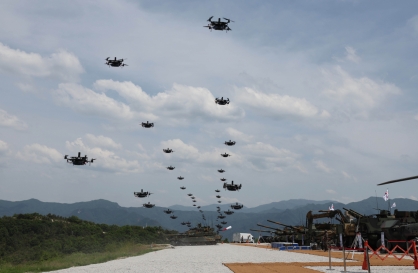3 regional clusters named for space development
Space committee adapts W1.4tr plan to develop small satellite system
By Kan Hyeong-wooPublished : Dec. 21, 2022 - 17:29

The South Korean government has designated three regions -- South Jeolla Province, South Gyeongsang Province and Daejeon city -- as clusters for the space industry, the Ministry of Science and ICT announced Wednesday.
The decision was made during a National Space Committee meeting held earlier in the day. Prime Minister Han Duck-soo presided over the meeting, which took place for the first time since the Yoon administration took office in May.
South Jeolla Province, home of the Naro Space Center in Goheung County where the country’s homemade Nuri rocket was successfully launched in June, has been named as a projectile cluster to nurture more rockets in the future. In order to encourage the private sector’s participation, the ministry said the government plans to build more launch pads and a projectile technology center for commercialization in the region.
South Gyeongsang Province has been tapped as a satellite cluster. The ministry said the region has many businesses relevant to the satellite industry and boasts excellent manufacturing capabilities. The government will expand facilities for space environment testing and establish an innovation center for building satellites in the region.
The government chose Daejeon as the cluster for developing research and nurturing talent. As Daejeon is already the home of the Korea Advanced Institute for Science and Technology, the ministry said it will look to foster space experts in the city based on its top-notch infrastructure for research.
To set up space-related facilities in these clusters, the Science Ministry will push for a preliminary feasibility assessment of an infrastructure-building project for the space industry worth about 800 billion won ($620 million). If the project is approved, the project will be carried out from 2024 to 2031.
The space committee also decided to begin the development project of a small satellite system, which is made up of many synthetic aperture radar satellites and electro optical satellites, to allow quick observation of the Korean Peninsula and the surrounding waters in contingency and strengthen the country’s national security countermeasures.
The government will invest 1.4 trillion won through 2030 to develop necessary satellites and a ground system.
Wednesday’s meeting was a follow-up discussion of President Yoon’s future space economy roadmap announced on Nov. 28 when he set the goals of landing on the moon and Mars by 2032 and 2045, respectively.
The space committee adopted the country’s fourth space development promotion basic plan with three specific goals. One was President Yoon’s moon and Mars exploration missions. The other two were doubling the government’s space investment to 1.5 trillion won in 2027 and increasing the Korean private sector’s share in the global space industry market's sales to 10 percent by 2045.
According to the ministry, the country’s private sector accounted for one percent of the global space industry's sales in 2020.
“Based on the blueprint set out to become a country with a strong space economy, the government will advance aerospace governance including the establishment of the Korea Aerospace Administration and develop cutting-edge technologies such as a lunar lander and next-generation rockets,” said Oh Tae-seog, first vice minister at the Ministry of Science and ICT.








![[New faces of Assembly] Architect behind ‘audacious initiative’ believes in denuclearized North Korea](http://res.heraldm.com/phpwas/restmb_idxmake.php?idx=644&simg=/content/image/2024/05/01/20240501050627_0.jpg&u=20240502093000)










